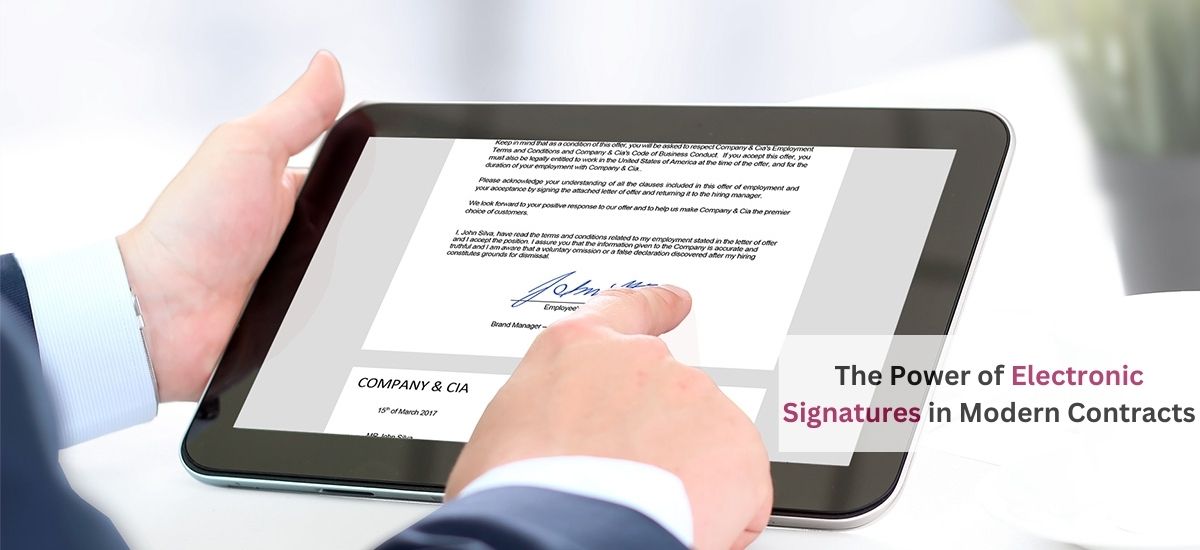In the digital age, the adoption of electronic signatures (e-signatures) has revolutionized the way contracts are executed. E-signatures offer a convenient, efficient, and legally binding way to sign documents, streamlining contract management processes in various industries. This article explores the power of e-signatures in modern contracts, examining their legal validity, advantages, challenges, and impact on business practices.
Understanding Electronic Signatures
An electronic signature is an electronic process or symbol attached to a contract, used to sign that document. They range from digitized versions of handwritten signatures to typed names, clicked buttons, or encrypted digital signatures. The fundamental purpose is to provide a secure and verifiable method of consenting to a document.
Legal Framework and Acceptance
E-signatures gained legal recognition through statutes like the U.S. Electronic Signatures in Global and National Commerce Act (ESIGN) and the Uniform Electronic Transactions Act (UETA). Globally, laws such as the EU’s eIDAS (Electronic Identification, Authentication, and Trust Services) regulation have also standardized their use. These laws ensure e-signatures have the same legal standing as traditional handwritten signatures.
Advantages of Electronic Signatures
- Efficiency and Convenience: E-signatures dramatically reduce the time taken to execute contracts. Parties can sign documents from different locations, eliminating the need for physical meetings or postal services. This convenience is invaluable for global businesses, allowing for seamless cross-border transactions.
- Cost-Effectiveness: Using e-signatures cuts down the costs associated with paper-based processes, such as printing, shipping, and storage. This cost-effectiveness makes it an attractive option for businesses looking to streamline operations and reduce overheads.
- Enhanced Security: E-signatures often come with security features like encryption and tamper-evident seals, making them more secure than traditional signatures. They provide a clear audit trail, which helps in verifying the authenticity of the signed document.
- Environmental Impact: Transitioning to e-signatures contributes to environmental sustainability by reducing the need for paper, which in turn decreases deforestation and carbon emissions associated with paper production and transportation.
Integrating E-Signatures into Business Practices
E-signatures have been widely adopted across various sectors including legal, finance, real estate, and healthcare. They are particularly useful in contract management, HR processes, and government services.
- Contract Management: In contract management, e-signatures simplify the execution process, making it faster and more efficient. They facilitate quicker deal closures and improve the overall experience for all parties involved.
- Human Resources: HR departments utilize e-signatures for onboarding processes, employee agreements, and policy acknowledgments. This integration streamlines HR operations and enhances the employee experience.
- Government Services: Many government services now accept e-signatures, improving the efficiency of administrative processes and making public services more accessible.
Legal and Compliance Issues
While widely accepted, e-signatures still face legal challenges in some jurisdictions and scenarios. It’s crucial for businesses to understand the legal framework in their specific region and industry. Compliance with international standards is also vital for cross-border transactions.
- Technological Barriers: The reliance on technology means that both parties need access to the necessary digital tools and a basic understanding of how to use them. This can be a barrier in regions with limited technological infrastructure or among populations with lower digital literacy.
- Security Concerns: While generally secure, e-signatures are not immune to cyber threats. Ensuring robust cybersecurity measures is essential to protect sensitive data associated with signed documents.
Future Trends and Developments
The use of e-signatures is expected to grow, driven by advancements in technology and a shift towards digital business practices. Future trends may include greater integration with blockchain technology for enhanced security and the use of artificial intelligence to streamline the signing process.
- Blockchain Integration: Blockchain technology offers a decentralized and tamper-proof way of managing e-signatures. This integration can further enhance the security and transparency of digital agreements.
- AI and Automation: Artificial intelligence can automate parts of the contract management process, including the identification of documents requiring signatures and the verification of signatory identities.
E-signatures represent a significant advancement in the way contracts are executed in the modern world. They offer a blend of efficiency, security, and cost-effectiveness, making them a vital tool for businesses and individuals alike. As technology continues to evolve, the role of e-signatures in contract management and other areas is set to grow, further transforming business practices and contributing to a more sustainable and efficient digital future. The adoption of e-signatures underscores the shift towards a more interconnected and digital-centric business environment, where agility and security are paramount.
Did you find this Legitt article worthwhile? More engaging blogs about smart contracts on the blockchain, contract management software and electronic signatures can be found in the Legitt Blogs section. You may also contact Legitt to hire the best contract lifecycle management services and solutions.
FAQs on Electronic Signatures
What is an electronic signature?
An electronic signature, or e-signature, is an electronic symbol or process attached to a contract, used as a method of signing that document.
Are electronic signatures legally binding?
Yes, e-signatures are legally binding in many jurisdictions, thanks to laws like the U.S. ESIGN Act and the EU’s eIDAS regulation.
What are the main advantages of e-signatures?
E-signatures offer efficiency, convenience, cost-effectiveness, enhanced security, and environmental sustainability by reducing paper use.
Can e-signatures be used in international contracts?
Yes, e-signatures are widely used in international contracts, but it’s important to ensure compliance with the legal standards of each involved jurisdiction.
Are e-signatures secure?
E-signatures generally offer enhanced security with features like encryption and tamper-evident seals, but they also require robust cybersecurity measures to protect against digital threats.
What industries commonly use e-signatures?
E-signatures are commonly used across various sectors, including legal, finance, real estate, healthcare, and government services.
How do e-signatures impact the environment?
E-signatures reduce the need for paper, thus contributing to environmental sustainability by decreasing deforestation and carbon emissions from paper production and transport.
Can e-signatures be integrated with blockchain technology?
Yes, integrating e-signatures with blockchain technology can enhance security and transparency, offering a decentralized and tamper-proof solution.
What are the challenges of using e-signatures?
Challenges include navigating legal and compliance issues, overcoming technological barriers, and addressing security concerns in the digital environment.
Will the use of e-signatures continue to grow?
The use of e-signatures is expected to grow, driven by technological advancements and the increasing shift towards digital business practices.






















